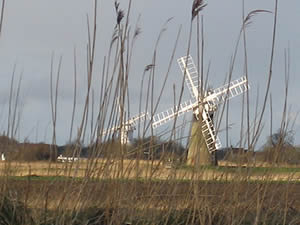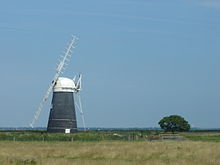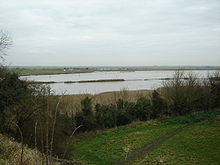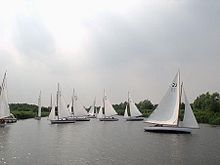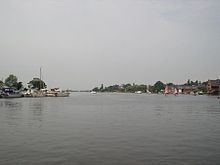
The Broads
Did you know...
SOS Children, an education charity, organised this selection. SOS Children is the world's largest charity giving orphaned and abandoned children the chance of family life.
The Broads are a network of mostly navigable rivers and lakes in the English counties of Norfolk and Suffolk. The Broads, and some surrounding land, were constituted as a special area with a level of protection similar to a National Park by The Norfolk and Suffolk Broads Act of 1988. The Broads Authority, a Special Statutory Authority responsible for managing the area, became operational in 1989.
The total area is 303 square kilometres (117 sq mi), most of which is in Norfolk, with over 200 kilometres (120 mi) of navigable waterways. There are seven rivers and 63 broads, mostly less than 4 metres (13 ft) deep. Thirteen broads are generally open to navigation, with a further three having navigable channels. Some broads have navigation restrictions imposed on them in autumn and winter.
Although the terms Norfolk Broads and Suffolk Broads are used to identify specific areas within the two counties respectively, the whole area is frequently mistakenly referred to as the "Norfolk Broads". The Broads has the same status as the national parks in England and Wales; the Broads Authority has powers and duties almost identical to the national parks, but is also the third-largest inland navigation authority. Because of its navigation role the Broads Authority was established under its own legislation on 1 April 1989. More recently the Authority wanted to change the name of the area to The Broads National Park in recognition of the fact that the status of the area is equivalent to the rest of the national park family, but was unable to get agreement from all the different parties. The Broads Authority Act 2009, which was promoted through Parliament by the Authority, improves public safety on the water.
Management
The Broads are administered by the Broads Authority. Special legislation gives the navigation of the waterways equal status with the conservation and public enjoyment of the area.
Specific parts of 'the Broads' have been awarded a variety of conservation designations, for instance:
- Special Protection Area (SPA) status for an area named 'Broadland' composed of 28 Sites of Special Scientific Interest
- Environmentally Sensitive Area (ESA) status for parts of the Halvergate Marshes
- National Nature Reserve (NNR) status for:
- Bure Marshes NNR
- Ant Broads & Marshes NNR
- Hickling Broad NNR
- Ludham - Potter Heigham NNR
- Redgrave and Lopham Fen
- Martham Broad NNR
- Calthorpe Broad NNR
- Mid-Yare NNR
A specific project being considered under the UK Biodiversity Action Plan is re-introduction of the Large Copper butterfly, whose habitat has been reduced by reduction of fens.
The Broads, although administered by the Broads Authority, give their name to the Broadland local government district, while parts of the Broads also lie within other council areas: North Norfolk, South Norfolk, Norwich and Great Yarmouth (all in Norfolk) and Waveney district in Suffolk.
History
For many years the broads were regarded as natural features of the landscape. It was only in the 1960s that Dr Joyce Lambert proved that they were artificial features, that they were flooded Mediaeval peat excavations. In the Middle Ages the local monasteries began to excavate the peat lands as a turbary business, selling fuel to Norwich and Great Yarmouth. The Cathedral took 320,000 tonnes of peat a year. Then the sea levels began to rise, and the pits began to flood. Despite the construction of windpumps and dykes, the flooding continued and resulted in the typical Broads landscape of today, with its reed beds, grazing marshes and wet woodland.
Various attempts were made to extend the navigable rivers. The longest-lasting was on the River Waveney, where an Act of Parliament passed on 17 March 1670 authorised improvements which included three locks, at Geldeston, Ellingham and Wainford. The head of navigation became a new staithe at Bungay. The new section was a private navigation which was not controlled by the Yarmouth Haven and Pier Commissioners, who had responsibility for the rest of the Broadland rivers. It remained in use until 1934 and, although the upper two locks have been replaced by sluices and Geldeston lock is derelict, the Environment Agency have negotiated with local landowners to allow use by canoes and unpowered vessels which can be portaged around the locks.
The next attempt was to extend navigation on the River Bure from Coltishall to Aylsham, which was authorised by an Act of Parliament on 7 April 1773. Five locks were built, to bypass mills, at Coltishall, Oxnead Lamas, Oxnead, Burgh and Aylsham. There were financial difficulties during construction, but the works were eventually completed and opened in October 1779. At Aylsham, a 1-mile (1.6 km) cut was made from the river to a terminal basin, where several warehouses were constructed. Despite the arrival of the railways in 1879, goods continued to be carried to Aylsham by wherries until 1912, when major flooding badly damaged the locks. Unable to fund repairs, the Commissioners closed the 9-mile (14 km) section above Coltishall, although it was not formally abandoned until 1928. All of the locks are derelict, but the course can still be used by canoes and light craft, which can be portaged around the locks.
The third attempt was to make the River Ant navigable from Dilham to Antingham. An Act of Parliament was obtained on 5 May 1812, which authorised the North Walsham & Dilham Canal, but work on its construction did not start until April 1825. The canal was a true canal, as its route did not use the bed of the river, and its construction, including six locks, was completed in 1826. It was about 8.75 miles (14.08 km) long, and the locks raised the level by 58 feet (18 m). In 1886 the canal was sold to a miller called Edward Press for £600, but the principal clerk absconded with most of the money and it was never recovered. In 1893 the section from Swafield locks to Antingham was abandoned, and the lower section was damaged by flooding in 1912. Some attempts were made to improve it in the 1920s, but the last commercial traffic used it in 1934, and it gradually became derelict after that. There is still a public right of navigation to Swafield, and there is a campaign to reopen it.
In 1814 the merchants of Norwich first suggested a plan to improve the route between Norwich and the North Sea, as the shallowness of Breydon Water created difficulties for trading vessels, and there was organised theft of cargo during its trans-shipment at Great Yarmouth, for which 18 men were convicted of taking the goods and one of receiving it in 1820. The initial plan was to dredge a deeper channel along the southern edge of Breydon Water, but the scheme was opposed by the people of Yarmouth. A more expensive scheme, involving the construction of a new cut to link the River Yare to the River Waveney, together with a channel between Oulton Broad and Lake Lothing, where a sea lock was needed, was also opposed by Yarmouth, but formed the basis of a Bill to Parliament. An Act of Parliament was passed on 28 May 1827, creating the Norwich and Lowestoft Navigation Company, and the work of construction and dredging of the River Yare and the Oulton Dyke was completed in 1833. The initial capital of £100,000 was inadequate and a further £50,000 was borrowed from the Exchequer Bill Loan Commission. The venture was not a commercial success, and, with expenditure exceeding income, the Company was unable to repay its loan. The Haddiscoe Cut was taken over by the Commissioners in 1842 and sold to the railway developer Sir Samuel Morton Peto.
Recreation
The Broads have been a boating holiday destination since the late 19th century. In 1878 small yachts were available to hire from John Loynes, and with easy access to the area by rail from London, Harry Blake created an agency for yachting holidays in 1908. The first boats were owned by the boatbuilder Ernest Collins of Wroxham, but other boatyards were soon added to the business. The range of boats expanded to include powered cruisers in the 1930s, and the Hoseasons agency was founded soon after the Second World War. By the 1980s the number of cruisers available for hire was 2,400, but had decreased to around 1,700 by 2004. For conservation reasons there is a strict speed limit enforced on all vessels, to reduce waves eroding the riverbanks. These speed limits are hardwired onto most rental vessels.
The Broads have also been an important centre for racing yachts since the late 19th century, and the design of the boats have included several innovative features, including short fin keels and a separate rudder. The design was eventually used on sea-going yachts from the 1960s.
The waterways are lock-free, although there are three bridges under which only small cruisers and smaller boats can pass. The area attracts all kinds of visitors, including ramblers, artists, anglers, and bird-watchers as well as people "messing about in boats". There are a number of companies hiring boats for leisure use, including both yachts and motor launches. The Norfolk Wherry, the traditional cargo craft of the area, can still be seen on the Broads as some specimens have been preserved and restored.
The late Ted Ellis, a local naturalist, referred to the Broads as "the breathing space for the cure of souls".
A great variety of boats can be found on the Broads, from Edwardian trading wherries to state-of-the-art electric or solar-powered boats. The Broads Authority are promoting sustainable boating, and the use of electric boats is being encouraged by the provision of charging points at a number of the mooring sites provided by the Authority.
Geography
The Broads largely follows the line of the rivers and natural navigations of the area. There are seven navigable rivers, the River Yare and its (direct and indirect) tributaries the Rivers Bure, Thurne, Ant, Waveney, Chet and Wensum. There are no longer any operational locks on any of the rivers (except for Mutford Lock in Oulton Broad that links to the saltwater Lake Lothing in Lowestoft, Suffolk), but all of the waterways are subject to tidal influence. The tidal range decreases with distance from the sea, with highly tidal areas such as Breydon Water contrasted with effectively non-tidal reaches such as the River Ant upstream of Barton Broad.
The broads themselves range in size from small pools to the large expanses of Hickling Broad, Barton Broad and Breydon Water. The broads are unevenly distributed, with far more broads in the northern half of Broadland (the Rivers Bure, Thurne and Ant) than in the central and southern portions (the Rivers Yare, Waveney, Chet and Wensum). Individual broads may lie directly on the river, or are more often situated to one side and connected to the river by an artificial channel or dyke.
Besides the natural watercourses of the rivers, and the ancient but artificial broads, there is one more recent navigation canal, the lock-less Haddiscoe Cut which connects the Rivers Yare and Waveney whilst permitting boats to by-pass Breydon Water.
There is also a second navigable link to the sea, via the River Waveney and its link to Oulton Broad. Oulton Broad is part of the Broads tidal system, but is immediately adjacent to Lake Lothing which acts as a harbour for Lowestoft and connects to the North Sea. Oulton Broad and Lake Lothing are connected by Mutford Lock, the only lock on the broads and necessary because of the different tidal ranges and cycles in the two lakes.
In the lists below, names of broads are emboldened to help distinguish them from towns and villages.
River Bure
The River Bure is a tributary of the River Yare which rises near Aylsham in Norfolk and joins the Yare just downstream of Breydon Water. On its way it flows through or passes:
- Coltishall
- Belaugh
- Belaugh Broad
- Bridge Broad
- Wroxham
- Hoveton
- Wroxham Broad
- Hoveton Great Broad
- Salhouse Broad
- Bure Marshes NNR ( National Nature Reserve)
- Salhouse
- Woodbastwick
- Decoy Broad
- Hoveton Little Broad (sometimes called 'Blackhorse Broad')
- Burnt Fen Broad
- Horning
- Cockshoot Broad
- Ranworth Broad
- Malthouse Broad
- Ranworth
- South Walsham
- St. Benet's Abbey
- Upton
- Upton Broad
- Upton Broads and Marshes Site of Special Scientific Interest
- Upton Fen
- Acle
- Oby
- Stokesby
- Mautby Decoy
- Great Yarmouth
River Thurne
The River Thurne is a tributary of the River Bure. It rises near Martham Broad and flows for about six miles (10 km) to Thurne Mouth where it joins the Bure. It is wide open and wind-swept, and on its way it flows through or passes:
- Upper Thurne Broads and Marshes Site of Special Scientific Interest
- Hickling Broad
- Hickling
- Horsey
- Horsey Mere
- Martham Broad (NNR) ( National Nature Reserve)
- Martham
- West Somerton
- Thurne
- Potter Heigham
- Ludham
- Ludham - Potter Heigham NNR ( National Nature Reserve)
- Womack Water
River Ant
The River Ant is a tributary of the River Bure. It rises at Antingham and joins the Bure at St. Benet's Abbey. It is winding and narrow, and on its way it flows through or passes:
- Honing
- North Walsham & Dilham Canal
- Dilham
- Dilham Broad
- Wayford Bridge
- Barton Broad
- Stalham
- Sutton
- Sutton Broad
- Ant Broads & Marshes NNR ( National Nature Reserve)
- Turkey Broad
- Alderfen Broad
- Catfield Broad
- Crome's Broad
- Neatishead
- Barton Turf
- Irstead
- How Hill
- Ludham Bridge
- Broad Fen
- Calthorpe Broad (NNR) ( National Nature Reserve)
- Ingham, Norfolk
River Yare
The River Yare rises south of Dereham and flows through the southern fringes of the city of Norwich, passes through Breydon Water and flows into the sea between Great Yarmouth and Gorleston. On its way it passes through:
- RSPB Breydon Water
- Halvergate Marshes, also RSPB reserve
- Halvergate
- Berney Arms
- RSPB Berney Marshes
- Reedham
- Cantley
- Carleton Broad
- Rockland Broad
- Wheatfen Broad
- Strumpshaw Fen
- RSPB Strumpshaw Fen ( Royal Society for the Protection of Birds reserve)
- Mid-Yare NNR ( National Nature Reserve)
- Surlingham
- Surlingham Broad
- Surlingham Church Marsh RSPB reserve.
- Brundall Broad
- Haddiscoe
- Haddiscoe Cut also known as New Cut
- Brundall
- Langley
- Postwick
- Thorpe St. Andrew
River Chet
The River Chet is a tributary of the River Yare. It flows through, or passes by:
- Loddon
- Chedgrave
- Hardley Flood
River Waveney
The River Waveney is a tributary of the River Yare, joining that river just upstream of Breydon Water. It flows through, or passes by:
- Burgh Castle
- Beccles
- Diss, Norfolk
- St. Olaves
- Herringfleet
- Somerleyton
- Fritton
- Fritton Decoy
- Gillingham
- Geldeston
- Burgh St. Peter
- Bungay
- Ditchingham
- Barnby Broad and Marshes
- Oulton Broad
- Lowestoft
River Wensum
The River Wensum rises near Fakenham in north-west Norfolk and flows south-east and through the centre of the city of Norwich before joining the River Yare just to the east of the city. Although the Wensum is the larger of the two rivers at their confluence, it is regarded as a tributary of the River Yare. The navigable section of the river is entirely urban and runs from the centre of Norwich, past Norwich Cathedral to the confluence with the Yare.
Trinity Broads
The Trinity Broads are an exception to the general rule, in that whilst they are connected to each other they have no navigable connection to the rest of the broads. The broads are:
- Rollesby Broad
- Ormesby Broad
- Filby Broad
- Lily Broad
- Ormesby Little Broad
Ecology
The Broads are Britain's largest protected wetland and are home to a wealth of wildlife, especially birdlife. Amongst the waterfowl: Mallard, Coot, Moorhen, Great Crested Grebe, Greylag Goose, Canada Goose, Egyptian Goose. Larger birds include Grey Heron, Cormorant, Kestrel, Sparrowhawk and Bittern.
The scarce Cetti's Warbler breeds in the Broads, and Britain's only breeding Common Cranes are found in the area.
Among the rare insects are the Norfolk hawker, a dragonfly and the Old World Swallowtail butterfly (Papilio machaon subsp. brittanicus).
Some of the broads are surrounded by fens, i.e. reed and sedge beds. Norfolk reed from the broads has been a traditional material for thatching houses.

